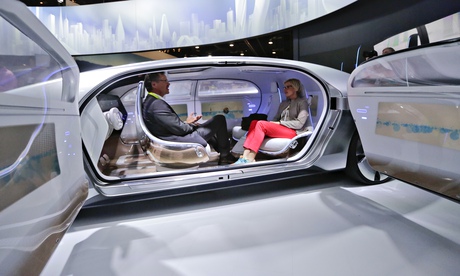
Las Vegas Strip, home to a dozen of the world’s biggest hotels and usually busy every hour of the day and night, was closed to traffic. Then, to the delight of the large crowd gathered outside the Cosmopolitan, a sleek silver car pulled into the kerb. But nobody got out.
The vehicle, not unlike the Hoff’s 1980s Knight Rider, was the star of the show on day one of this year’s Consumer Electronics Show – the biggest, gaudiest, noisiest trade show in the US.
More than 150,000 people from 170 countries were in town for the four-day event to get a look at the 20,000 new gadgets, gizmos and tech trends, ranging from double-screened smartphones and helmets that promote hair growth to wardrobes that steam clean their contents (then shake out any creases). And, of course, driverless vehicles.
The one outside the Cosmopolitan was the Mercedes F 015 Luxury in Motion. It had inward facing seats, set around a little coffee table, LED displays front and back to communicate with other drivers and pedestrians, and gesture recognition, so it can be controlled with body movements.
For those who really can’t let go of the past, there was also a steering wheel, although Mercedes insisted it will really not be necessary when the car appears in showrooms in 15 years’ time.
Fortunately for technophiles, most of the gadgets and technology on display at the CES will be with us, on us and in our homes a lot sooner than that. Here are some of the highlights:
Health and fitness gadgets
These are no longer just about counting steps. The gizmos on display measure your heart rate, blood pressure and muscle tone. And they are better looking too. Judy Tomlinson, chief executive of wearable technology company FashionTEQ, said: “We’re really starting to see the fashion of wearables come through.”
The latest fitness trackers can be woven directly into shirts, shorts, socks and pants, meaning clunky wristbands might soon be a thing of the past.
“Smart textiles can solve some of the problems seen by wearables,” explained Stanislas Vandier, deputy chief executive of French wearable technology firm Cityzen Sciences. “We can place the sensors precisely where they need to be while making them hidden and flexible.”
The prototypes on show included smart shirts, packed with movement and flex sensors and capable of monitoring a wearer’s heart rate. The data is then beamed to a smartphone.
Early examples such as a shirt for tracking tennis performance or a pair of cycling shorts for recording rides could be on the shelves by Christmas. And socks that track a run using pads on the soles of the feet are now available for £130. Sadly, they can only be washed 35 times.
Superchips
These include the Nvidia Tegra X1, with 256 processor cores and eight CPU cores. What does that even mean? “More power than a supercomputer the size of a suburban family home from 15 years ago,” according to the maker.
8K TV
4K may be new in Currys, but it’s been overtaken already. Sharp just unlocked a new level. It’s not strictly 8K because it uses pixel-splitting to produce “virtual 8K”. It also requires shows and films to be made in 8K. But that will come.
Internet of Things
This much heralded breakthrough could finally be happening this year. “We’re entering the third age of technology,” said Samsung UK vice president Robert King. “It’s no longer about standalone devices but interconnecting them so they can do more together.”
Samsung says every one of its products, including washing machines and driers, would be internetconnected within five years. New smarthome accessories include fridges that know what’s on their shelves to locks that will let family members into the house.
Driverless cars
The Mercedes was not the only model on show. Audi had a car that can arrive to pick up its driver at the touch of a button on a smartwatch, while Japanese carmaker Nissan announced it was teaming up with Nasa to work on the technology too. BMW executive Dr Werner Huber said fully autonomous cars were still some years away, but a helpful robot co-driver could be commonplace far sooner.
“We are closer to the autonomous car, but not in the sense that you can read a newspaper behind the wheel,” said Huber. “It’s better to have a combination of the driver and a robotic system.
Drones
The halls of the CES were buzzing with these. They included the Nixie, that turns from a bracelet to a flying camera drone when flung into the air.
There were flying robots to carry loads, to fly into tight spaces, to provide lighting and just for toys. There was also “follow me” technology in some drones, so they can track and film anyone wearing a device on their wrist. All be available before the year is out.
Chris Anderson, chief executive of drone maker 3D Robotics, said the attraction of drones was simple: “You want a flying phone, but until we invent anti-gravity, drones are basically it.”
Robots
Standard non-flying bots weren’t left out of the CES party, and included toys to teach kids how to code. But robotics is also about boosting the performance of the human body.
Nate Harding, chief executive and cofounder of Ekso Bionics, said: “People will be running faster and jumping further, and grannies will be showing off their new hip exoskeletons.”
Exoskeleton devices that help people to carry heavy loads, and others that could enable paralysed people to walk again, were also on show.

